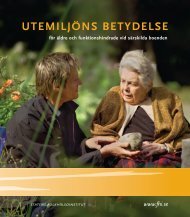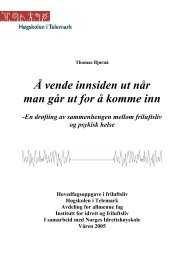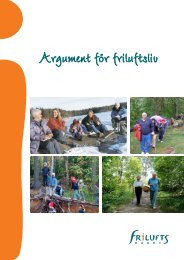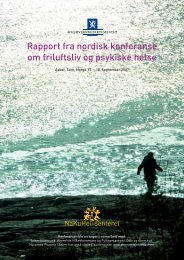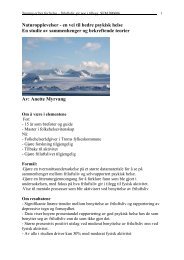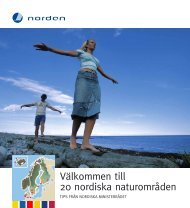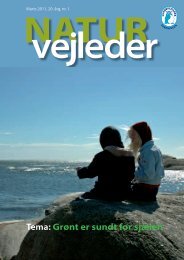Green Care: A Conceptual Framework - Frisk i naturen
Green Care: A Conceptual Framework - Frisk i naturen
Green Care: A Conceptual Framework - Frisk i naturen
Create successful ePaper yourself
Turn your PDF publications into a flip-book with our unique Google optimized e-Paper software.
community movement, or a single local therapeutic community.<br />
While it could answer some questions about therapeutic<br />
communities, there would be massive problems and large<br />
costs. This is not to say that RCTs should not be done where<br />
appropriate.<br />
Other approaches may be needed first, though and continued<br />
monitoring of therapeutic communities through a variety of<br />
assessment methods will be necessary not only to replace<br />
RCTs if cost or feasibility rules them out, but also to check<br />
whether RCT results are sustainable and generalisable.”<br />
(Manning, 2004, p. 119)<br />
There are two important messages from Manning’s comments that can be<br />
applied to green care; the first is that the RCT should not be the required<br />
standard for the green care movement and for individual projects. The<br />
second is that RCTs should be carried out where appropriate. If we wish<br />
to claim the effectiveness of a clearly defined intervention within green<br />
care on a specific group of clients then controlled trials are the way. In such<br />
circumstances they are feasible. Indeed, this was the approach taken by<br />
Berget et al (2007) in studying the effects of animal assisted therapy on a<br />
group of psychiatric patients.<br />
However, where interventions are more diverse and client groups are<br />
heterogeneous, for example, as in the case of care farming, such studies are<br />
far more difficult. They require much greater resources and such resources,<br />
unfortunately, are not plentiful in the field of green care research.<br />
One other point from Manning’s conclusion that is important is the notion<br />
of continued monitoring… through a variety of assessment methods. This<br />
represents a way in which practitioners (in partnership with researchers)<br />
can help to continue to build the evidence base for green care.<br />
There will be no definitive RCT of green care itself. Researchers will<br />
continue to collect data on discrete aspects of it. This will include RCTs and<br />
qualitative work that will create a broad evidence base that encompasses<br />
different green care approaches and research disciplines. Indeed, within<br />
the context of green care research, evidence is drawn from a number of<br />
different sources. These are shown in Table 8.1, below. The classification is<br />
not intended as a hierarchy but as an overview of the source of the research<br />
material.<br />
115







